Distinguishing between aluminum and stainless steel cookware is essential for selecting the right pots and pans for your cooking needs. While both materials are popular choices in the kitchen, they have distinct characteristics that set them apart.
Understanding how to tell aluminum from stainless steel cookware can help you make informed decisions when purchasing or using cookware.
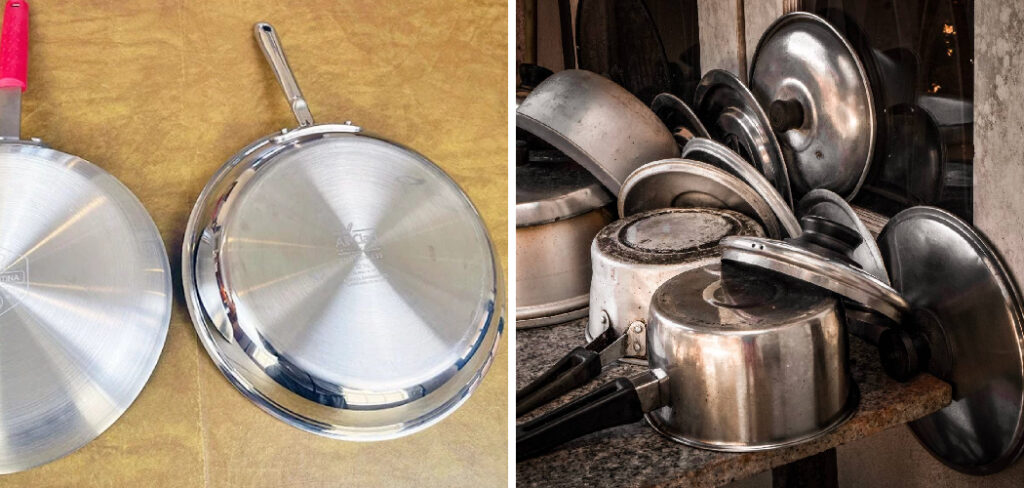
From examining appearance and weight to conducting simple tests using magnets or acidic substances, there are several methods you can use to identify the material composition of your cookware accurately.
In this article, we’ll explore these methods in detail, providing you with the knowledge and confidence to differentiate between aluminum and stainless steel cookware effortlessly.
THe Difference Between Aluminum and Stainless Steel Cookware
Knowing the difference between aluminum and stainless steel cookware is crucial for several reasons.
Aluminum is a lightweight material known for its excellent heat conductivity, making it ideal for cookware that requires quick and even heating. However, it is also more prone to scratching and can react with acidic foods, potentially altering the flavor of your dishes.
On the other hand, stainless steel cookware is heavier, highly durable, and resistant to corrosion and rust. It does not react with foods, ensuring that your meals are free of any metallic taste.
Additionally, stainless steel cookware often features a core of aluminum or copper sandwiched between layers of steel, combining the best of durability and heat conductivity. Understanding these differences enables you to choose cookware that best suits your cooking style, preferences, and the culinary tasks at hand.
Benefits and Characteristics of Aluminum and Stainless Steel Cookware
When deciding between aluminum and stainless steel cookware, it’s helpful to consider the unique benefits and characteristics each material offers.
Aluminum Cookware:
- Lightweight: Aluminum’s light nature makes cookware easy to handle, an essential feature when dealing with hot pots and pans.
- Superior Heat Conductivity: Aluminum heats up quickly and evenly, reducing hotspots that can cause uneven cooking.
- Cost-Effective: Generally, aluminum cookware is less expensive than stainless steel, offering a budget-friendly option without compromising on quality.
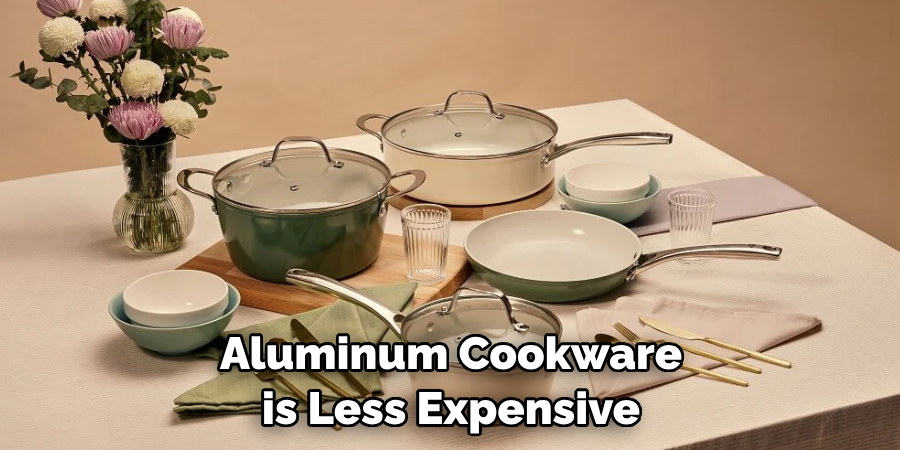
However, aluminum’s drawbacks include its susceptibility to warping under high heat and its potential reaction with acidic or alkaline foods. To mitigate these issues, anodized aluminum, treated to prevent corrosion and reactions with food, can be a better choice for some cooks.
Stainless Steel Cookware:
- Durability: Stainless steel is renowned for its toughness; it resists dents, scratches, and can last for decades with proper care.
- Non-Reactive Surface: It does not impart any metallic taste to food, regardless of the ingredients’ acidity or alkalinity.
- Versatility: Suitable for almost every cooking method, stainless steel can go from the stovetop to the oven without worry.
One downside is that stainless steel can have poorer heat conductivity compared to aluminum. However, many stainless steel cookware pieces counteract this by incorporating an aluminum or copper core, blending the best of both materials for excellent heat distribution and retention.
In sum, both aluminum and stainless steel cookware have their place in the kitchen. The choice between the two depends on personal preferences, cooking styles, and the specific culinary tasks at hand. By understanding the benefits and characteristics of each, home cooks can select the most suitable cookware to enhance their cooking experience.
Understanding Aluminum Cookware
Aluminum cookware stands out in the culinary world due to its exceptional heat conductivity, which ensures rapid and even heat distribution across the cooking surface. This feature is particularly beneficial for recipes requiring precise temperature control to avoid under or overcooking.
Aluminum’s lightweight nature is another advantage, allowing for easy handling and maneuverability during cooking processes, which is especially helpful when flipping or tossing ingredients.
Despite these benefits, it’s crucial to acknowledge the potential downsides of aluminum cookware. Its softness makes it susceptible to dents and scratches, which could shorten its lifespan compared to more robust materials like stainless steel.
Additionally, untreated aluminum can react with acidic or alkaline foods, potentially leading to alterations in taste and color of the food. To address these concerns, manufacturers have introduced anodized aluminum cookware.
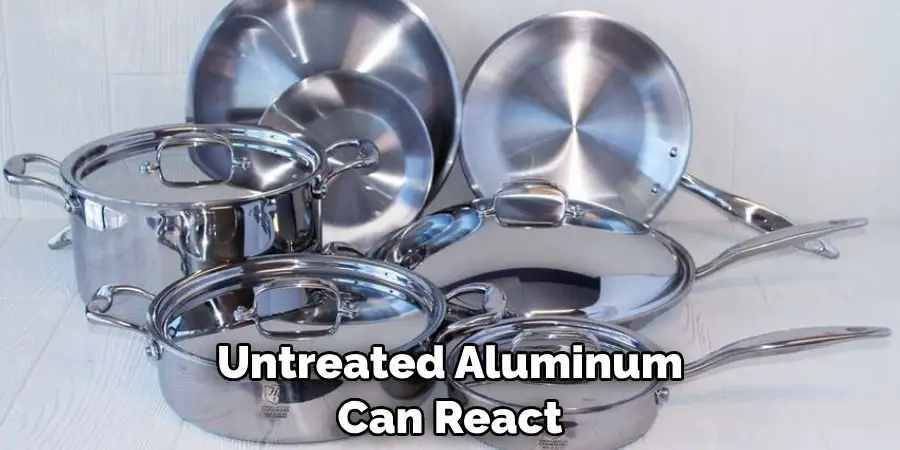
This process involves treating the aluminum to create a harder, non-reactive surface that resists corrosion, enhances durability, and prevents food from interacting with the metal. When considering aluminum cookware for your kitchen, weighing the advantages of superior heat conductivity and lightweight design against the material’s reactive nature and durability concerns is key.
Opting for anodized aluminum can mitigate some of these issues, providing a more resilient and non-reactive cooking surface.
Understanding Stainless Steel Cookware
Stainless steel cookware is highly valued in both professional kitchens and homes for its exceptional durability and non-reactive nature. This type of cookware is made from an alloy that includes iron, carbon, and at least 10.5% chromium, which provides a protective layer that resists rust and corrosion.
One of the standout features of stainless steel cookware is its ability to maintain a pristine appearance over years of use, resisting scratches, dents, and tarnishing.
Unlike aluminum, stainless steel does not react with acidic or alkaline foods, making it safe for cooking a wide range of dishes without impacting flavor or color. This non-reactive quality ensures that stainless steel cookware is a versatile choice for any cooking task, from searing meats to simmering hearty tomato-based stews.
While pure stainless steel has poorer heat conductivity compared to aluminum, many high-quality stainless steel cookware pieces mitigate this drawback by incorporating a core of aluminum or copper sandwiched between layers of stainless steel.
This innovative construction enables the cookware to heat up quickly and distribute heat evenly, combining the best of durability, non-reactivity, and efficient heat management.
Another advantage of stainless steel cookware is its compatibility with various cooking surfaces, including induction cooktops, and its oven-safe quality, offering flexibility in cooking methods.
Whether you are a professional chef or a home cook, understanding the enduring value and versatile performance of stainless steel cookware can help you make informed choices that enhance your culinary creations.

Visual and Physical Differences for Aluminum and Stainless Steel Cookware
When comparing aluminum and stainless steel cookware, both the visual and physical attributes are crucial in distinguishing between the two materials and understanding their suitability for various cooking tasks.
Visual Differences:
- Color and Shine: Aluminum cookware typically has a matte, silver finish that lacks the high shine of stainless steel. In contrast, stainless steel cookware boasts a bright, reflective surface that can add an aesthetic appeal to any kitchen.
- Surface Texture: Aluminum pots and pans may show more wear over time, such as scratches and dents, due to its softer nature. Stainless steel, known for its durability, often maintains its smooth, unblemished appearance longer.
Physical Differences:
- Weight: Aluminum cookware is noticeably lighter than stainless steel, making it easier to handle, especially when transferring from stovetop to oven or serving. This difference can significantly impact the cooking experience, particularly for those who value ease of maneuverability in the kitchen.
- Heat Conductivity and Distribution: One of the most distinct physical differences is in their heat handling capacities. Aluminum heats up and cools down rapidly, offering outstanding heat conductivity which is ideal for recipes requiring precise temperature control. Stainless steel, albeit slower to heat and more prone to hot spots, benefits from the inclusion of aluminum or copper cores in high-quality cookware, which helps improve heat distribution.
- Reactivity: From a chemical standpoint, aluminum is more reactive with acidic and alkaline foods, which might not only affect the food’s flavor and appearance but also the longevity of the cookware. This reactivity is virtually nonexistent in stainless steel cookware, making it a safer choice for cooking a broader variety of dishes without concern for chemical reaction.
Both materials have their unique benefits and drawbacks from a visual and physical standpoint. The choice between aluminum and stainless steel cookware depends on the individual’s cooking style, the dishes they frequently prepare, and their aesthetic preference for their kitchenware.
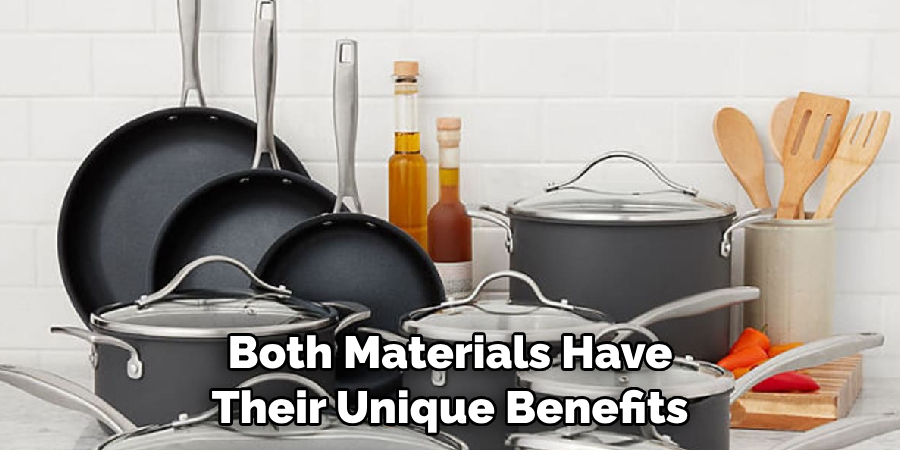
10 Methods How to Tell Aluminum from Stainless Steel Cookware
1. Visual Inspection:
One of the simplest ways to differentiate between aluminum and stainless steel cookware is through visual inspection. Aluminum cookware typically has a dull, matte finish, while stainless steel cookware tends to have a shiny, reflective surface. Look closely at the cookware’s appearance to determine whether it has the characteristic luster of stainless steel or the more subdued finish of aluminum.
2. Weight Comparison:
Aluminum cookware is generally lighter in weight compared to stainless steel cookware. Pick up the cookware and feel its weight in your hand. Aluminum cookware will feel noticeably lighter, while stainless steel cookware will have a heftier feel due to its denser construction.
3. Magnetic Test:
Stainless steel is a ferrous metal, meaning it contains iron and is magnetic. Aluminum, on the other hand, is non-magnetic. To perform a magnetic test, simply hold a magnet against the surface of the cookware. If the magnet sticks, it is likely stainless steel. If the magnet does not stick, the cookware is likely aluminum.
4. Heat Conductivity:
Aluminum is an excellent conductor of heat, while stainless steel is not as efficient. If you’re unsure about the material of your cookware, you can conduct a heat conductivity test. Heat the cookware on the stove and observe how quickly it heats up. Aluminum cookware will heat up faster and more evenly than stainless steel cookware.
5. Appearance of Surface Scratches:
Scratches on aluminum cookware may reveal a dull, whitish surface underneath the outer layer, while scratches on stainless steel cookware may reveal a shiny, metallic surface. Use a small, inconspicuous area of the cookware to test for this characteristic.
6. Reaction to Acidic Foods:
Aluminum cookware may react with acidic foods, causing discoloration or imparting a metallic taste. To test for this, cook a small amount of acidic food, such as tomato sauce or lemon juice, in the cookware and observe for any changes in color or taste. Stainless steel cookware, on the other hand, is non-reactive and will not affect the flavor or appearance of acidic foods.
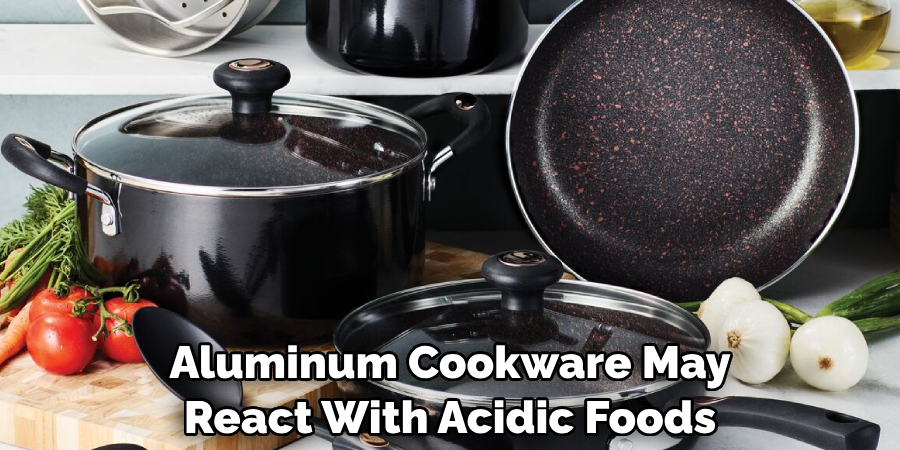
7. Sound Test:
Tap the cookware with your knuckles and listen to the sound it produces. Aluminum cookware tends to produce a higher-pitched, ringing sound, while stainless steel cookware produces a lower-pitched, duller sound. This difference in sound can help you distinguish between the two materials.
8. Price Comparison:
In general, stainless steel cookware is more expensive than aluminum cookware due to its higher durability and longevity. If you’re unsure about the material of your cookware, comparing prices can provide a clue. However, keep in mind that price alone may not be a reliable indicator, as there are many factors that can affect the cost of cookware.
9. Manufacturer Labeling:
Check for any manufacturer labeling or markings on the cookware that indicate the material composition. Many manufacturers label their cookware with the type of metal used, making it easy to identify whether the cookware is made of aluminum or stainless steel.
10. Consult Product
Documentation: If you still can’t determine the material of your cookware, refer to the product documentation or user manual that came with the cookware. Manufacturers often provide detailed information about the materials used in their products, including whether the cookware is made of aluminum, stainless steel, or other materials.
Conducting the Magnet Test
The magnet test is an uncomplicated yet effective method for distinguishing between aluminum and stainless steel cookware. Because stainless steel contains iron, it exhibits magnetic properties; aluminum, by contrast, does not. To perform this test, you will need a magnet – any common refrigerator magnet will suffice.
Steps for the Magnet Test:
- Prepare the Magnet: Ensure your magnet is clean and free from any debris that might affect its ability to stick to surfaces.
- Test the Cookware: Place the magnet gently against the surface of the cookware. If the cookware is stainless steel, the magnet should adhere firmly. Conversely, if the cookware is aluminum, the magnet will not stick and will slide off easily.
- Check Multiple Areas: For comprehensive results, perform the test on various parts of the cookware, including the base and sides. Some stainless steel cookware might have non-magnetic parts, so testing multiple areas ensures accuracy.
- Interpreting Results: If the magnet sticks to the cookware, it is highly likely made of stainless steel. If the magnet does not stick, you can be confident the cookware is made of aluminum.
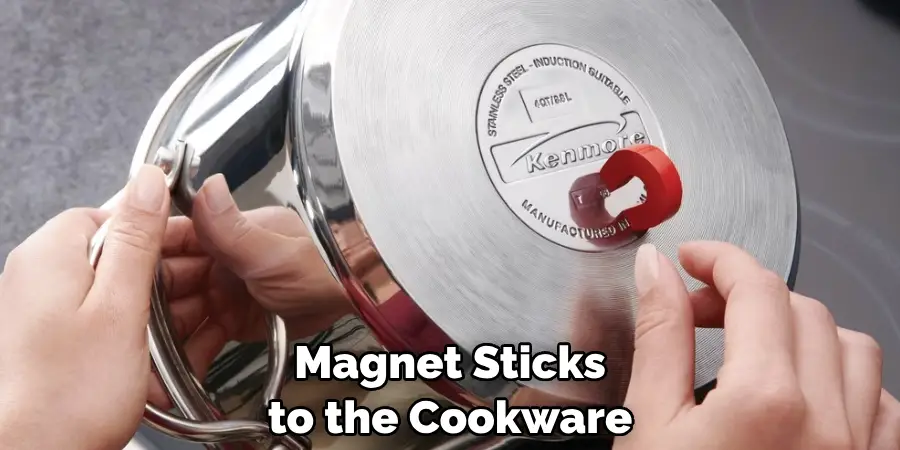
Considerations:
- Mixed Materials: Be aware that some cookware might use a combination of aluminum and stainless steel, especially in multi-layered bases designed to enhance heat conductivity. In such cases, the magnet test might still reveal the presence of stainless steel, but other properties (like weight and heat conductivity) could suggest a blend of materials.
- Magnet Strength: The strength of your magnet might affect the test’s outcome. Stronger magnets are more likely to give clear results, especially on stainless steel with lower magnetic properties.
By conducting the magnet test, you can quickly and easily determine the primary material of your cookware, aiding in your culinary adventures and care practices for your kitchenware.
Consideration of Price and Quality
When distinguishing between aluminum and stainless steel cookware, it’s crucial not to base your judgment solely on price.
While stainless steel cookware generally commands a higher price due to its durability and resistance to corrosion, aluminum cookware offers superior heat conductivity, often at a more affordable price point. However, this doesn’t mean that aluminum cookware is inferior in quality.
High-quality aluminum cookware often features an anodized surface, which significantly enhances its durability, reduces the risk of corrosion, and lessens the material’s reactivity with acidic foods.
On the other hand, premium stainless steel cookware often incorporates multiple layers, including a core of aluminum or copper to improve heat distribution, marrying the best qualities of both materials.
The price and quality of cookware are also influenced by factors such as the thickness of the material, construction quality, brand reputation, and additional features like non-stick coatings or compatibility with induction cooktops.
Therefore, when assessing cookware, it’s important to consider both the price and the specific qualities that meet your cooking needs and preferences. Remember, the most expensive option isn’t always the best one for every kitchen or cooking style, and sometimes mid-range cookware offers the best balance between price, performance, and longevity.
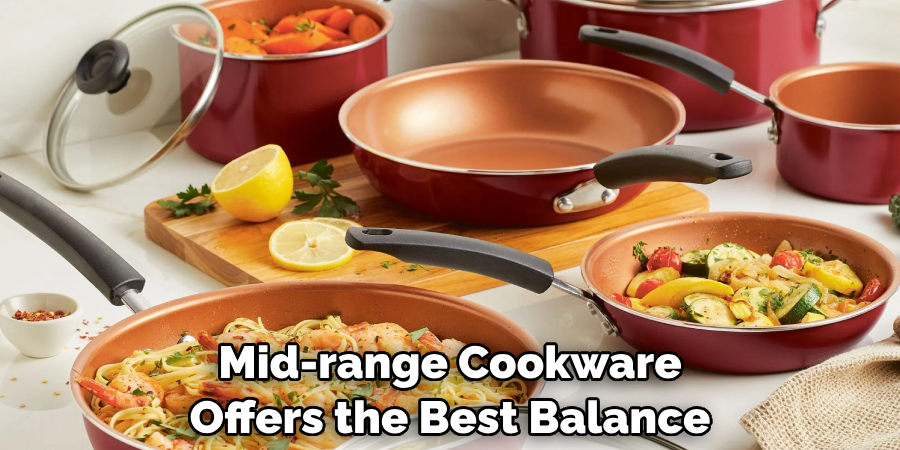
Conclusion
In conclusion, being able to distinguish between aluminum and stainless steel cookware is essential for making informed purchasing decisions and optimizing cooking experiences.
By understanding the characteristics, visual cues, and simple tests outlined in this guide, individuals can confidently identify the material of their cookware. Whether it’s the lightweight and excellent heat conductivity of aluminum or the durability and corrosion resistance of stainless steel, each material offers unique benefits and considerations for cooking.
By applying the knowledge gained from this comprehensive guide, individuals can choose the most suitable cookware for their needs, whether it’s for everyday cooking or special occasions.
Additionally, being able to properly care for and maintain aluminum and stainless steel cookware ensures their longevity and performance in the kitchen. Thanks for reading, and we hope this has given you some inspiration on how to tell aluminum from stainless steel cookware!
Professional Focus
Angela Ervin, a former interior designer turned blogger, specializes in kitchen design and renovations. Through her website, she blends her passion for cooking with design expertise, sharing practical and creative ideas. Known for balancing functionality and beauty, Angela’s insightful content has made her a trusted voice in home design and lifestyle.
About the Author
Angela Ervin, an experienced interior designer and blogger, combines her passion for kitchen renovations with storytelling. Living in Petersburg with her family, she enjoys cooking and testing her projects firsthand. Known for her humor and relatable style, Angela shares creative, functional design insights through her content, making her a trusted voice in home design.
Education History
University: Virginia Commonwealth University
Degree: Bachelor of Fine Arts (BFA) in Interior Design
- Angela’s education at VCU focused on mastering core interior design principles, including spatial planning, color theory, materials selection, and sustainable design practices.
- She gained hands-on experience through studio projects and collaborative design exercises, which honed her ability to create functional and aesthetically pleasing environments.
- Her coursework also emphasized problem-solving and practical applications of design, preparing her for real-world projects like her self-directed kitchen renovations.
- The program’s strong foundation in both technical skills and creative expression shaped Angela’s ability to seamlessly integrate form and function in her work.


